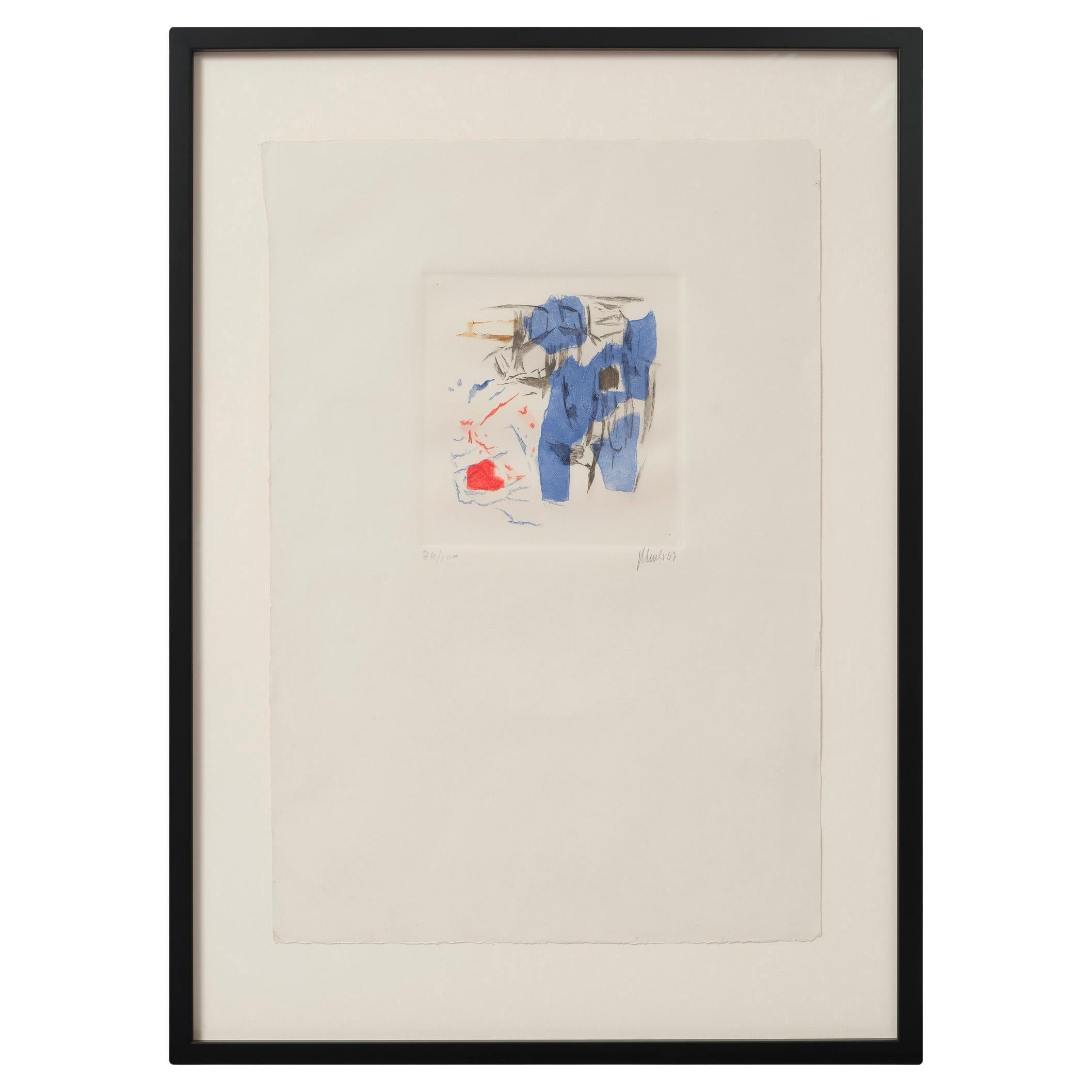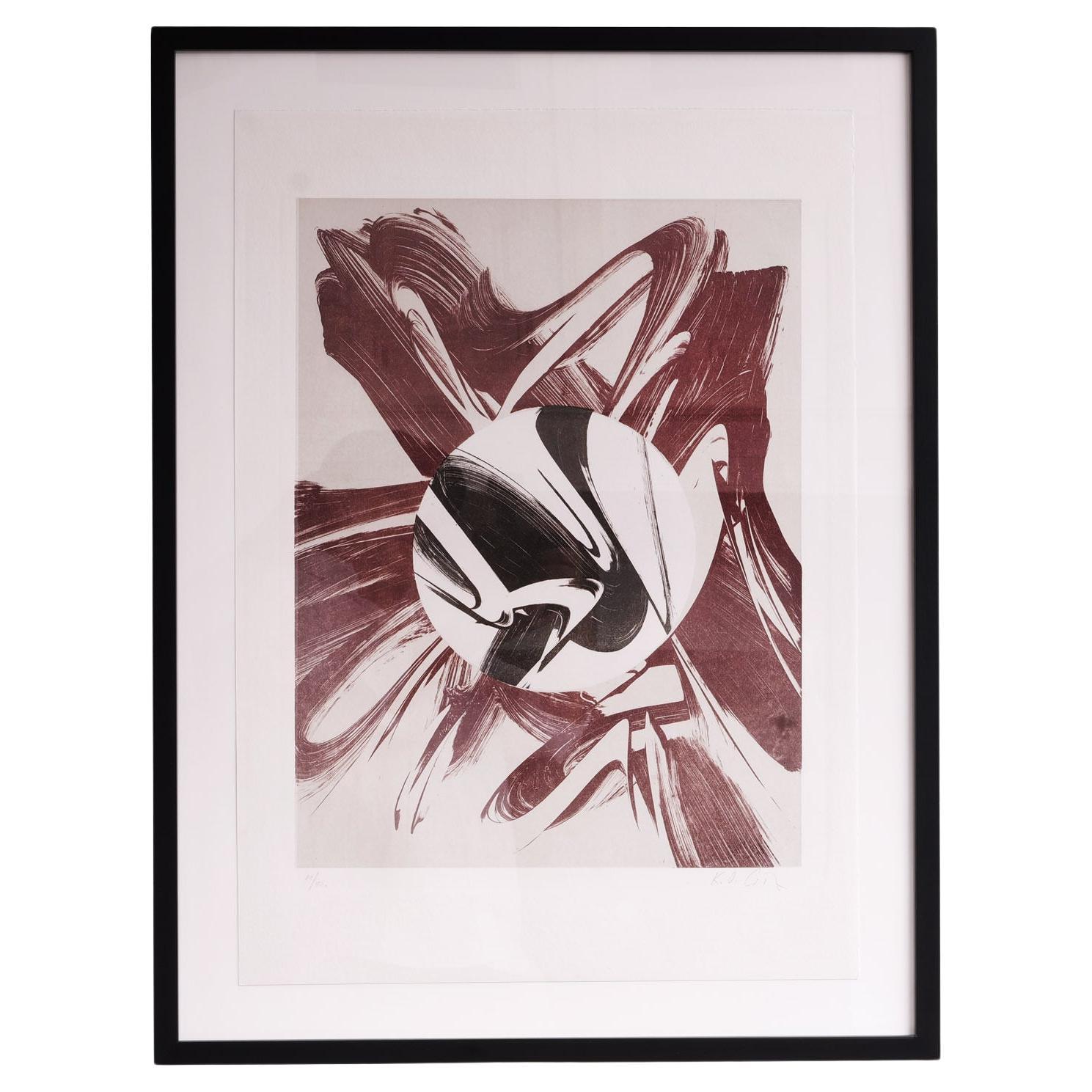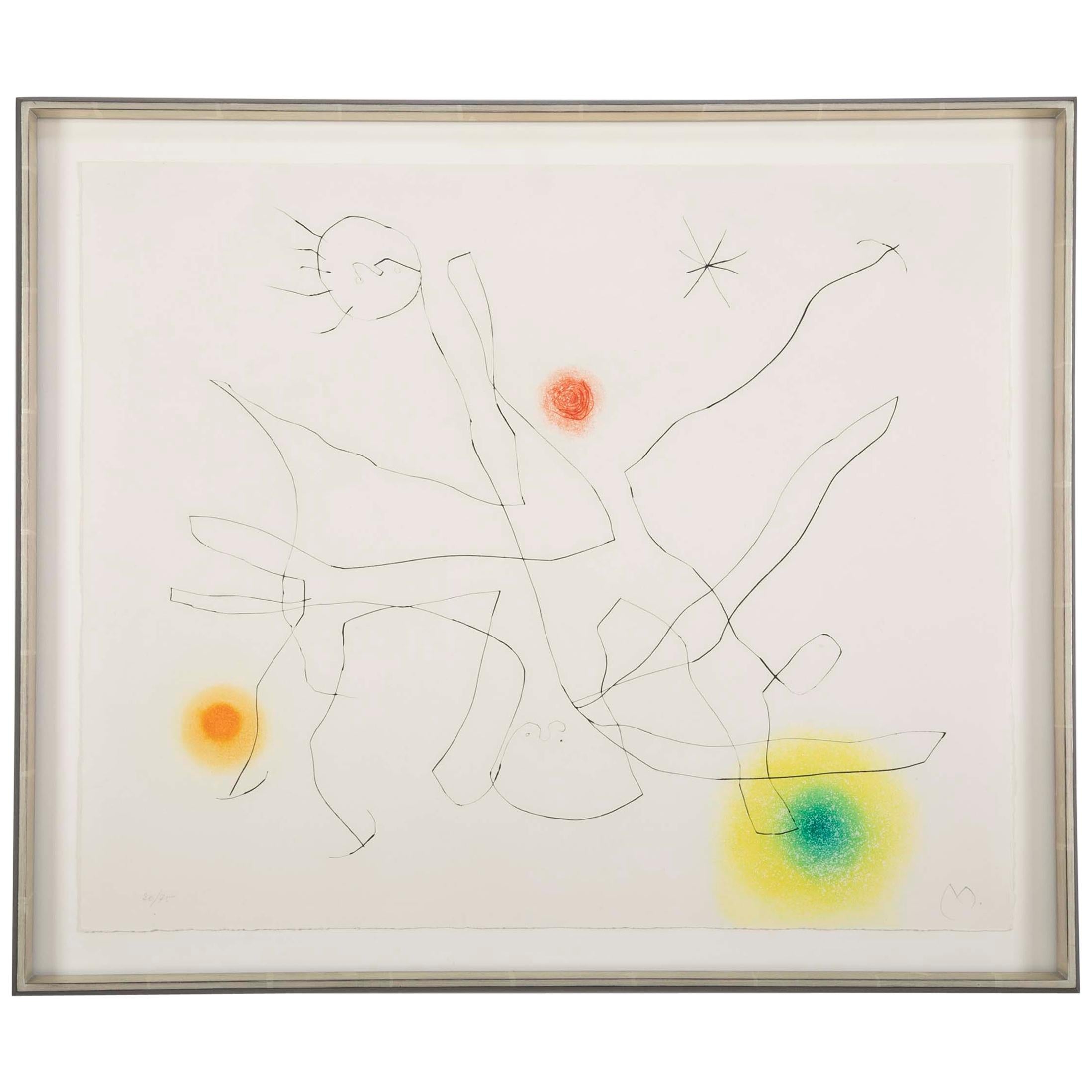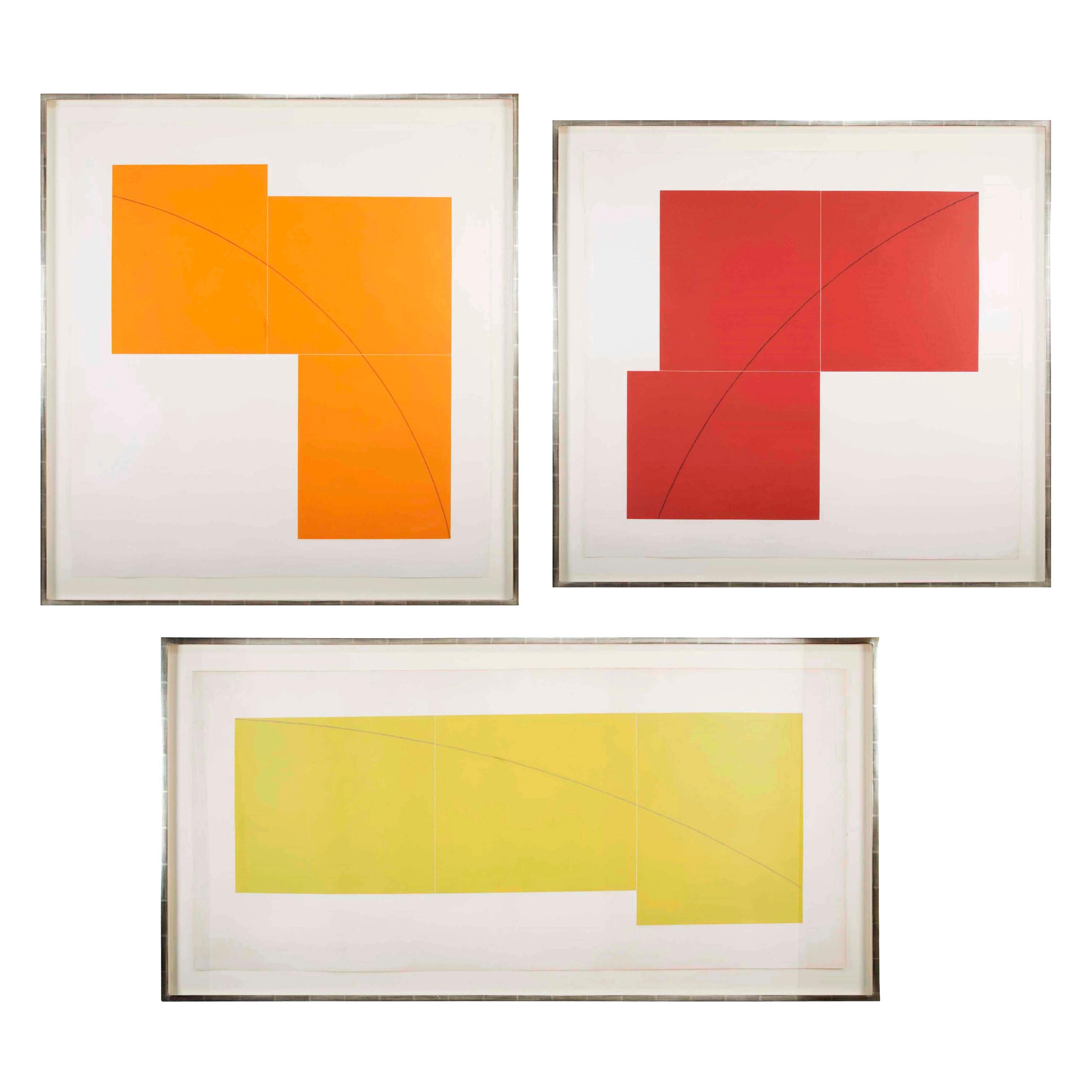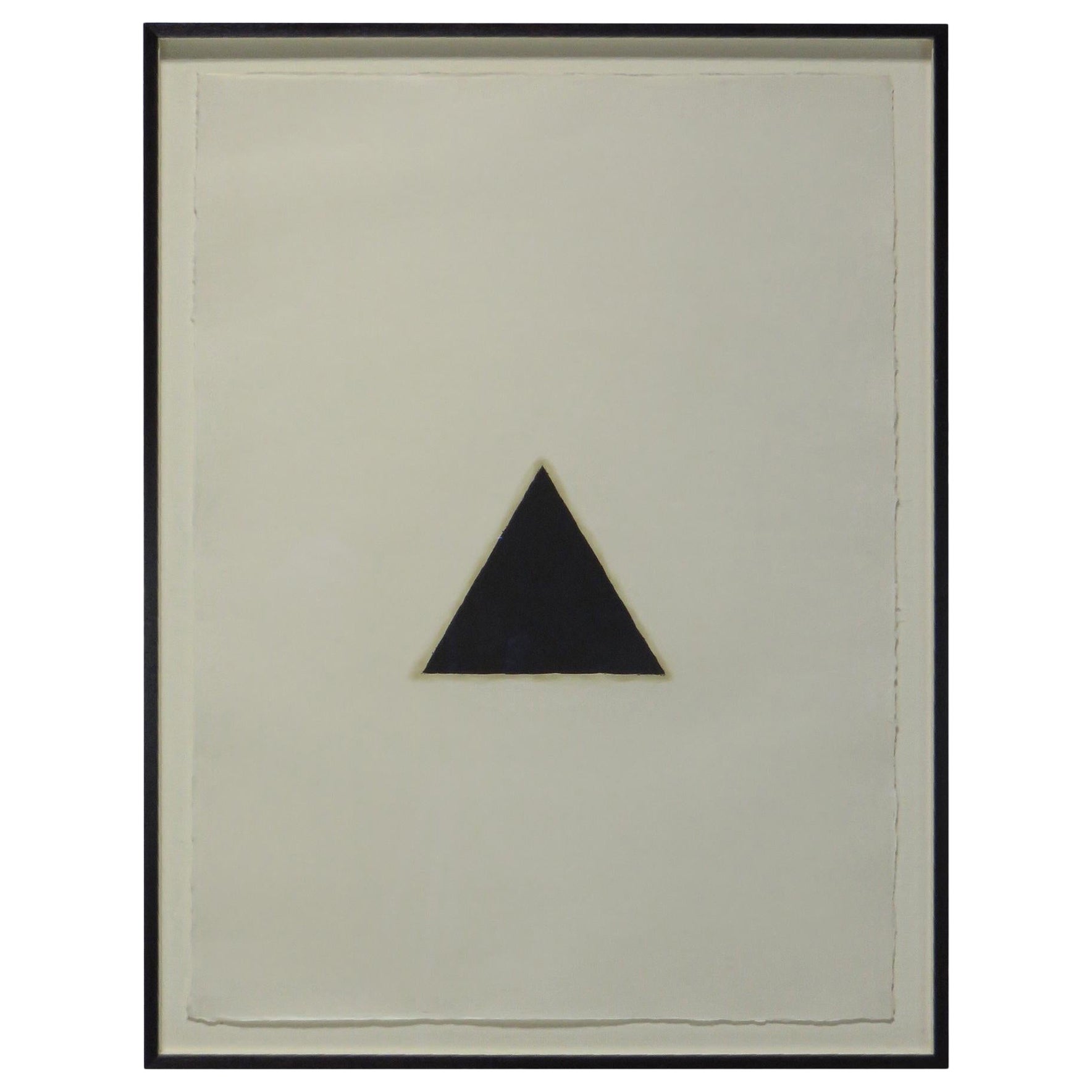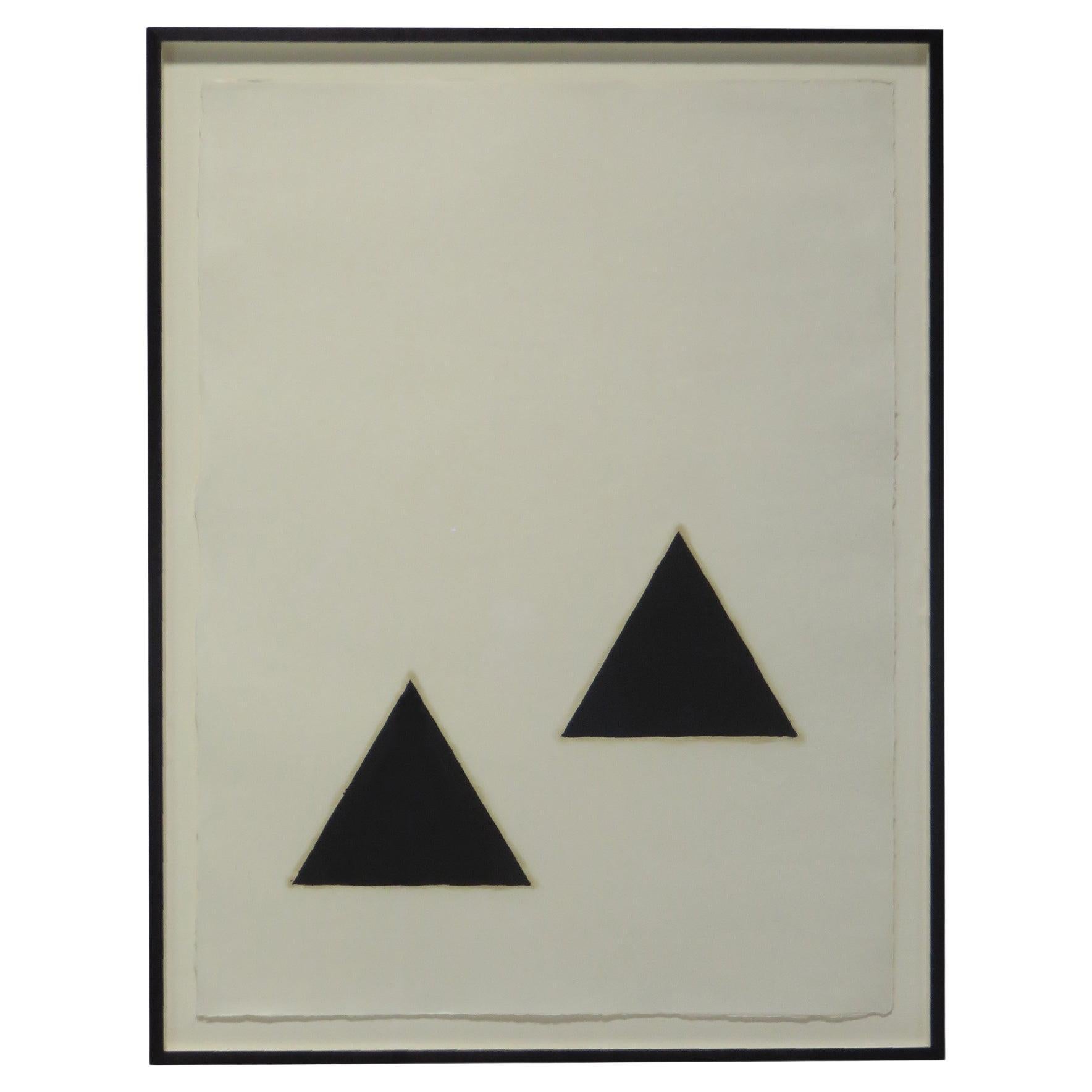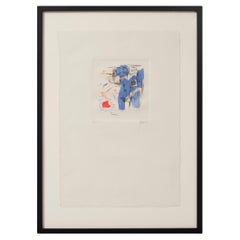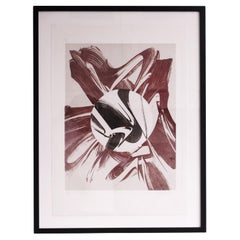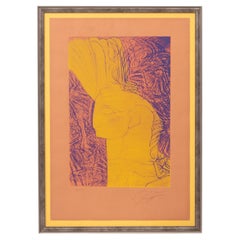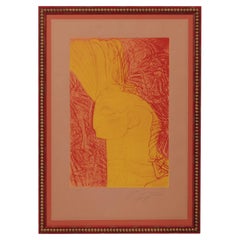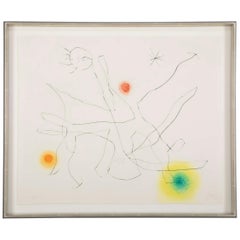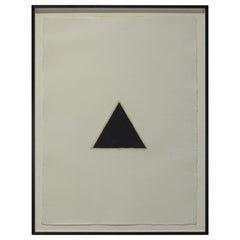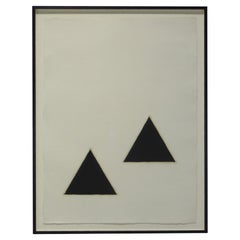Items Similar to Fritz Winter "black, light English red " color aquatint of 2 plates, 1967
Want more images or videos?
Request additional images or videos from the seller
1 of 5
Fritz Winter "black, light English red " color aquatint of 2 plates, 1967
About the Item
Fritz Winter (1905 Altenbögge - 1976 Herrsching am Ammersee)
“black, light English red”
Color aquatint of 2 plates, created in 1967
Edition of 100 numbered and signed copies on Rives laid paper,
Printer; Signovert, Saulx les Chartreux
signed and numbered by hand
EX. 8/100
Published by: Marbach, Bern
framed behind glass
Dimensions:
56 x 38 cm (sheet size)
The painter and graphic artist is one of the outstanding protagonists of German post-war art. In his balanced, abstract compositions, which he created from around 1930, he drew on the art of the “Blaue Reiter” and the Bauhaus. From the 1950s onwards, he explored the stylistic devices of Art Informel and color field painting. In doing so, he always sought to make the hidden elementary forces and structures of nature visible.
Inspired by the works of Modersohn-Becker and van Gogh, he produced his first paintings in 1924. From 1927 to 1930, he studied at the Dresden Bauhaus under Kandinsky, Klee and Schlemmer.
He also visited Kirchner in Davos in 1929/30. In 1930, he moved to Berlin, where he worked for some time in Gabo's studio and held his first solo exhibition in Germany. He also founded the studio community “Studio Z” with artist friends. In 1931/32, he taught at the Pedagogical Academy in Halle. In 1937 he was banned from painting and Winter now worked in seclusion in Diessen am Ammersee. After the war, he moved to Munich, where he co-founded the artist group “ZEN 49” in 1949. In 1953, he taught as a visiting professor at the Landeskunstschule Hamburg. In 1954, he leaves the Deutscher Künstlerbund after a dispute with its first chairman Karl Hofer about abstract painting. In 1955 he accepted a professorship at the Kunsthochschule Kassel and took part in the documenta (also in 1959). In 1965, he presented his work in the first major retrospective. Winter received numerous awards, including the 1st Prize of the Deutscher Künstlerbund Berlin in 1951, the Tokyo International Graphic Arts Prize in 1957 and the Order “Pour le Mérite” in 1972.
- Dimensions:Height: 28.35 in (72 cm)Width: 20.48 in (52 cm)Depth: 1.19 in (3 cm)
- Style:Modern (Of the Period)
- Materials and Techniques:
- Place of Origin:
- Period:
- Date of Manufacture:1967
- Condition:Wear consistent with age and use.
- Seller Location:Münster, DE
- Reference Number:1stDibs: LU9172244347722
About the Seller
5.0
Recognized Seller
These prestigious sellers are industry leaders and represent the highest echelon for item quality and design.
Established in 2000
1stDibs seller since 2023
- ShippingRetrieving quote...Shipping from: Münster, Germany
- Return Policy
Authenticity Guarantee
In the unlikely event there’s an issue with an item’s authenticity, contact us within 1 year for a full refund. DetailsMoney-Back Guarantee
If your item is not as described, is damaged in transit, or does not arrive, contact us within 7 days for a full refund. Details24-Hour Cancellation
You have a 24-hour grace period in which to reconsider your purchase, with no questions asked.Vetted Professional Sellers
Our world-class sellers must adhere to strict standards for service and quality, maintaining the integrity of our listings.Price-Match Guarantee
If you find that a seller listed the same item for a lower price elsewhere, we’ll match it.Trusted Global Delivery
Our best-in-class carrier network provides specialized shipping options worldwide, including custom delivery.More From This Seller
View AllFritz Winter "blue, brown, red, black" color aquatint of 3 plates, 1967
Located in Münster, DE
Fritz Winter (1905 Altenbögge - 1976 Herrsching am Ammersee)
“Blue, brown, red, black”
Color aquatint of 3 plates, created in 1967
Edition of 100 numbered and signed copies on Riv...
Category
Vintage 1960s German Modern Contemporary Art
Materials
Paint, Paper
Karl Otto Götz color lithograph untitled 1967
Located in Münster, DE
Karl Otto Götz color lithograph
1.450,00 € incl. VAT
Karl Otto Götz (1914 Aachen - 2017 Wolfenacker)
Color lithograph "untitled", signed and dated, created 1967, framed behind glass
...
Category
Vintage 1960s German Modern Contemporary Art
Materials
Paper
Ernst Fuchs (1930 - 2015) "Head of a cherub", created in 1982 Color silkscreen
By Ernst Fuchs
Located in Münster, DE
Ernst Fuchs (1930 - 2015)
"Head of a cherub", created in 1982
Color silkscreen, ed. 200 pieces, signed and numbered
Dimensions 67.7 cm x 45 cm
Ernst Fuchs was born on February 13, 1930 in Vienna Ottakring as the only child of Maximilian and Leopoldine Fuchs; his father was of Jewish descent, which is why his grandfather and father emigrated to the USA and Shanghai in 1938 after the annexation of Austria by the Third Reich. To protect little Ernst from anti-Semitic hostility, it was decided to baptize him according to the Roman Catholic rite in 1942. The 12-year-old Ernst Fuchs was allowed to choose his own baptismal name and chose Ernst Peter Paul, in honor of the painter Peter Paul Rubens, whom he admired at the time. Around the same time, his godmother's brother, the painter and restorer Alois Schiemann, taught him the basics of drawing and painting. Until the age of 15, he attended the St. Anna painting school in Vienna, where he was taught sculpture and painting by Emmy Steinböck and Fritz Fröhlich.
After the war, Ernst Fuchs was finally able to take up his longed-for studies at the Academy of Fine Arts in Vienna, which he had previously been denied for racist reasons. His teachers were first Robin Andersen, then Albert Paris Gütersloh. While still a student, he was allowed to hold his first solo exhibition in Paris in 1949, and soon afterwards, in 1950, he also moved to the French capital. Ernst Fuchst traveled through Europe and the USA for six years before taking an extended stay at the Dormition Monastery on Mount Zion in Israel in 1957 to study icon painting in depth. He finally returned to Vienna in 1962, where he founded the Vienna School of Fantastic Realism with former fellow students, of which he himself was to become the most important representative. The early years in particular were characterized by a strong surrealism; mythical and religious symbols in particular appealed to Ernst Fuchs and permeated his work. Later, Fuchs turned increasingly to Mannerism.
Ernst Fuchs' artistic spectrum broadened over the years: he sang and recorded various albums, which, like the majority of his paintings, were inspired by mystical motifs, and he designed stage sets for such famous operas as Wagner's Parsifal and Lohengrin or Mozart's Die Zauberflöte. Ernst Fuchs also wrote philosophical treatises. He repeatedly collaborated with other artists, including the musicians Klaus Schulze...
Category
Vintage 1980s Austrian Modern Contemporary Art
Materials
Paper
Ernst Fuchs (1930 - 2015) "Head of a cherub", created in 1982 Color silkscreen
By Ernst Fuchs
Located in Münster, DE
Ernst Fuchs (1930 - 2015)
"Head of a cherub", created in 1982
Color silkscreen, ed. 200 pieces, signed and numbered
Dimensions 67.7 cm x 45 cm
Ernst Fuchs was born on February 13, 1930 in Vienna Ottakring as the only child of Maximilian and Leopoldine Fuchs; his father was of Jewish descent, which is why his grandfather and father emigrated to the USA and Shanghai in 1938 after the annexation of Austria by the Third Reich. To protect little Ernst from anti-Semitic hostility, it was decided to baptize him according to the Roman Catholic rite in 1942. The 12-year-old Ernst Fuchs was allowed to choose his own baptismal name and chose Ernst Peter Paul, in honor of the painter Peter Paul Rubens, whom he admired at the time. Around the same time, his godmother's brother, the painter and restorer Alois Schiemann, taught him the basics of drawing and painting. Until the age of 15, he attended the St. Anna painting school in Vienna, where he was taught sculpture and painting by Emmy Steinböck and Fritz Fröhlich.
After the war, Ernst Fuchs was finally able to take up his longed-for studies at the Academy of Fine Arts in Vienna, which he had previously been denied for racist reasons. His teachers were first Robin Andersen, then Albert Paris Gütersloh. While still a student, he was allowed to hold his first solo exhibition in Paris in 1949, and soon afterwards, in 1950, he also moved to the French capital. Ernst Fuchst traveled through Europe and the USA for six years before taking an extended stay at the Dormition Monastery on Mount Zion in Israel in 1957 to study icon painting in depth. He finally returned to Vienna in 1962, where he founded the Vienna School of Fantastic Realism with former fellow students, of which he himself was to become the most important representative. The early years in particular were characterized by a strong surrealism; mythical and religious symbols in particular appealed to Ernst Fuchs and permeated his work. Later, Fuchs turned increasingly to Mannerism.
Ernst Fuchs' artistic spectrum broadened over the years: he sang and recorded various albums, which, like the majority of his paintings, were inspired by mystical motifs, and he designed stage sets for such famous operas as Wagner's Parsifal and Lohengrin or Mozart's Die Zauberflöte. Ernst Fuchs also wrote philosophical treatises. He repeatedly collaborated with other artists, including the musicians Klaus Schulze...
Category
Vintage 1980s Austrian Modern Contemporary Art
Materials
Paper
A.R. Penck Color etching, “untitled”, 1990s
By A.R. Penck (Ralf Winkler)
Located in Münster, DE
A.R. Penck (1939 Dresden - 2017 Zurich)
Color etching, “untitled”, created in the 1990s, signed and numbered by hand, ed. 35, copy 32/35
Sheet size: 65.5 x 89.5 cm
Frame size: ...
Category
1990s German Modern Contemporary Art
Materials
Paint, Paper
Heinz Mack (*1931 Lollar) “untitled” Color silkscreen, 2013
Located in Münster, DE
Heinz Mack (*1931 Lollar)
“untitled”
Created in 2013
Color silkscreen on wove paper, signed, numbered and dated by hand
EX. 31/70
framed behind museum glass
Dimensions:
She...
Category
2010s German Modern Contemporary Art
Materials
Paint, Paper
You May Also Like
"Flux de L' Aimant" Drypoint & Color Aquatint by Joan Miro
By Joan Miró
Located in Stamford, CT
" Flux de L' Aimant " drypoint & color aquatint on BFK Rives paper by Joan Miro; circa 1964. Signed lower right, and numbered 20/75, lower left, in pencil. Published by Maeght Editeu...
Category
Mid-20th Century Spanish Mid-Century Modern Contemporary Art
Materials
Paper
Complete Set of “Three Aquatints”, Prints by Robert Mangold
By Robert Mangold
Located in Stamford, CT
A complete set of “Three Aquatints” prints by Robert Mangold. Published by Parasol Press Ltd., on Rives BFK paper. Each signed, numbered and annotated A, B, C in pencil. Framed using...
Category
Vintage 1970s American Modern Prints
Materials
Paper
Aquatints by Tadaaki Kuwayama
Located in San Francisco, CA
Tadaaki Kuwayama, Aquatints, 1990, on hand made Ichibei Iwano Japanese paper, each signed in pencil,
Printed by Wingate Studio, New Hampshire.
Framed: Height: 35" Width: 26.5"
Shee...
Category
21st Century and Contemporary Japanese Modern Contemporary Art
Materials
Paper
Aquatints by Tadaaki Kuwayama
Located in San Francisco, CA
Tadaaki Kuwayama, Aquatints, 1990, on hand made Ichibei Iwano Japanese paper, each signed in pencil,
Printed by Wingate Studio, New Hampshire.
Category
21st Century and Contemporary Modern Contemporary Art
Materials
Paper
Jim Dine Signed Aquatint Etching Print With Hand Coloring of Mysterious Man
By Jim Dine
Located in Studio City, CA
A beautiful aquatint etching print by famed American artist Jim Dine (1935- ). The image is printed on wove paper with hand coloring and featured a fabulously and somewhat flamboyan...
Category
20th Century American Modern Contemporary Art
Materials
Glass, Wood, Paper
Signed, 1981, Jasper Johns Aquatint
By Jasper Johns
Located in Los Angeles, CA
Signed, dated and numbered, 1981 aquatint and color etching on Rives BFK paper- Periscope, by iconic American artist, Jasper Johns (b. 1930). Marked 22 /88 on the lower left. Signed ...
Category
Vintage 1980s American Contemporary Art
Materials
Paper
